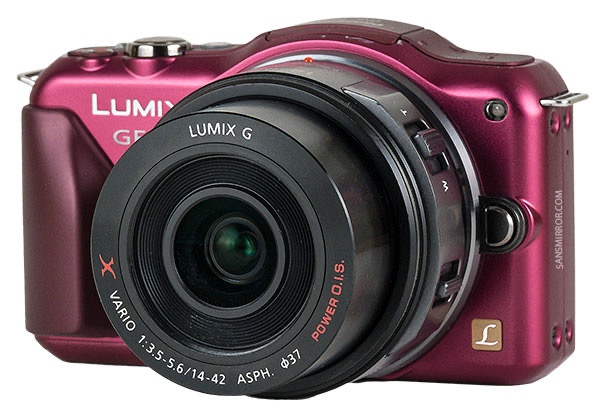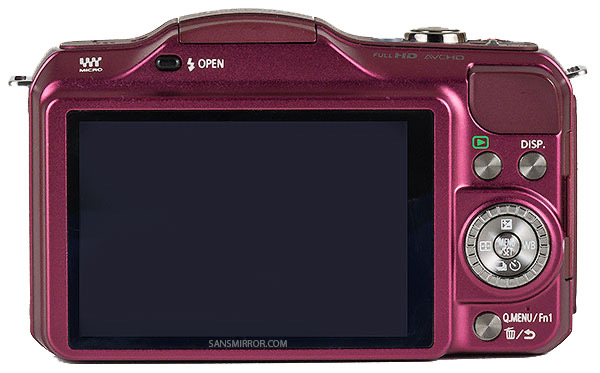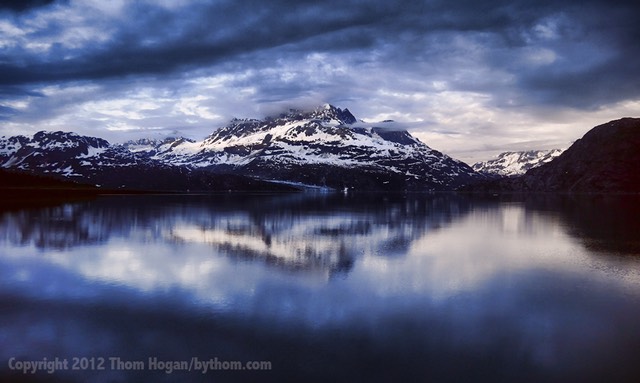
What is It?
The Panasonic GF5 is the fourth in the GF series, the entry level of Panasonic's m4/3 offerings. This time around, most of the changes are internal. The GF5 gets a slightly updated 12.1mp sensor, plus the new Venus VII processing engine. Focus performance was improved. The continuous frame rate improved to 4 fps from 3.2. The LCD goes to 921k dot (from 460k) and gets GX1 style touch controls.
Other than that, not a lot changed. The camera body itself stayed the same with only some modest mostly cosmetic changes, mostly with the buttons (now chrome). We did gain a DISP button. We also gained a slightly grippier grip, now with a different texture that improves one-handed holding.
The GF5 remains the smallest, most compact Panasonic interchangeable lens camera. And it remains the most basic.
By basic I mean it. There aren't a lot of controls to figure out: shutter release, record movie button, iAuto button, on-off switch, flash release button, playback button, DISP button, Q.MENU/Fn1/Delete/Return button (yes four functions), and a control pad with a dial and a four additional buttons via edge presses. Plus, of course, the touch screen.
The big news on the back is the 3" 921k dot touch sensitive LCD, which is fixed in place. We don't get the swivel flexibility of the G3, but we do get the touch capabilities of the GX1. I wouldn't call the LCD bright, but it's reasonably usable outdoors.
While shooting you can set crops of 4:3, 3:2, 1:1, and 16:9. The sensor always crops, so at 16:9 you get a bit less than 12mp output. The sensor is now a slight bit outdated, but still does well for the purpose this camera is intended for.
The menus are simplified and similar to the Sony NEX at the top level (six touchable icons takes you to the deeper menus, which are also touch sensitive). The serious user will find there's a lot of capability and flexibility buried in the menus for an entry camera.
The GF5 is no GH2 when it comes to motion, but it does have some reasonable video specs, including 17Mbps 1080i/60 (NTSC regions; PAL users get 1080i/50).
In terms of performance specifications, the GF5 is actually a pretty mid-range shooter: 4 fps at full resolution, 7 shot raw buffer (unlimited with JPEG with a fast card), 1/160 flash sync speed, 1/4000 top shutter speed. ISO starts at 160 and can be set to up to 12800.
Despite the very simplified design, there's not a lot missing from this camera. So the real question is whether you like the handling of the simplified design or not.
How's it Handle?
Without a Mode dial, you may wonder how you set modes. Press the MENU button, select Rec Mode, rotate the dial around the Direction pad to the mode you want. It's no more cumbersome than the Sony NEX style of setting exposure mode, indeed it pretty much mimics it in many ways. If you're into touching the LCD: touch the exposure mode area on the display, pick a new mode by touching it. Again, simple and to the point.

Most of the rest of the things you'd want to set are accessible via the Q.Menu (Quick Menu), either via the Q.Menu button or the touchscreen virtual button. Simple enough. Exposure compensation is one of the Direction pad edge presses (coupled with the dial around the Direction pad). Aperture or Shutter Speed is set via the dial. Everything is simple and direct.
Overall, I wasn't particularly bothered by the simplification. In fact, with the modest changes to the touchscreen implementation, I've come to enjoy shooting with the GF5. With the 14-42mm X (power) lens, it makes for a very compact jacket pocket camera that's highly competent. The only advantage of the GX1 over the GF5 now that the GX1 has the 16mp sensor and a few additional external controls, but with the GX1 you get a bigger camera, too. The GF5's control structure is better than the E-PM1, in my opinion. Some of you might miss a top command or mode dial, but don't dismiss this camera just because it doesn't have a control you expect. I adopted to its controls very quickly, and came to enjoy them.
Panasonic has pretty much perfected the Quick Menu concept. On the GF5 you have only one way of triggering it: the QMENU button. That's fine, and coupled with the other GX1 inspired changes, the touch screen interface makes a lot of sense to me now.
While not quite as complex as the other Panasonic cameras, the detailed menu system, once you get to it, is deep and wide. This is a bit of a good thing for serious users considering the simplified GF5, as it gives you a level of customization over the camera (at the expense of menu complexity). If you've used one of the other Panasonic bodies, you won't find much missing in the GF5 menus, which is a little odd, but as I note, very welcome for serious shooters. Entry level shooters will probably avoid the menu system for the most part, as it's 21 pages (!) of terminology and complexity that will initially flumox them. Thankfully, you can pretty much avoid the menus for basic stuff.
Non-cluttered and well organized come to mind when contemplating the GF5, with only the deeper menu system detracting a bit from that.
The fixes to the grip material are very nice touches, showing that Panasonic has been paying attention to what users have been flustered about. I complained about the texture of the GF3 grip, and here the GF5 comes along and fixes that. (Not that Panasonic noted my complaint, but rather that they're catching common user complaints and addressing them.
One small nit: the battery compartment door now has a rubber insert in it, apparently for AC or supplemental power supply. This makes the camera slightly more prone to water ingression for a feature I really don't see matching up against the low-end position of this camera. I found that flap not completely down several times during one week-long trip with the camera, in a climate where drizzle was the norm.
How's it Perform?
Battery: We still have a small battery, only 940mAh, so don't expect a lot out of it. I got 300+ images per charge off it with coaxing, but that was with aggressive sleep and power management. You'll want to carry extra batteries, for sure. The battery is not the same as the GX1, G3, or GF2, by the way.
Flash: Surprisingly useful, though not powerful. The GN of 6.3m at base ISO means only f/2.1 at about 10 feet (3m) in complete darkness. Like the other Panasonic bodies, my measurements say it doesn't quite achieve that, but it's only about a half stop off. You're at a level where adding flash will make a meaningful difference in most situations you'd try to use it for fill. Still, with fast primes on the GF5 you don't have enough horsepower to light even small groups at night when they're 20 feet (6m) away. Think of the flash as good for single portrait or fill flash work. For groups or further subjects, it wimps out quickly.
For close in subjects, Panasonic's set the flash output too high, with no easy way to get a better balance between flash and ambient. The camera really needs a flash exposure compensation setting. You can manually bounce the flash by holding it backwards a bit with your finger, and this can help, but it helps because you're losing flash power doing that, mostly.
Focus: For single focus (static subjects), most people will find it good. For tracking moving subjects, it's close to a Fail except with people when face detection is set. Basically the focus level is now up to the GX1 level, which is good enough for most single shot use.
Image Quality: Most people will consider this camera against the Olympus E-PM1 or E-PM2. Whereas I said that the E-PM1 won against the GF3, the race now nods slightly in the GF5's favor against the E-PM1 (but slightly in the E-PM2's favor). It's all actually a very close call, as Olympus has always had good, contrasty JPEG output with very hidden noise reduction. The GF5 doesn't quite punch as much with JPEG images, but I actually prefer having slightly more subtle, not over-the-top out-of-camera output, as it's easier to modify such images after the fact.
In raw output the GF5 is very slightly better than my E-PM1. The E-PM1 seems to have a bit more color noise to it than my GF5, especially at ISO 1600 and 3200. The E-PM2 is better than the GF5, though; that Sony sensor in the new Olympus is a winner.
Overall, I can get very reasonable images out of ISO 1600 GF5 raw files. At ISO 3200 I start to struggle to get the kind of image I want; the noise level is just starting to get out of the correctable-without-major-consequences range.
I was a little surprised to see that Olympus got clearly more dynamic range out of the same sensor than Panasonic did. This shows up mostly in the highlights, but there's a teeny bit more in the shadows too. It even seems to show up in raw files, but not nearly enough of a difference to fret over. When two cameras are within a half stop of each other, the accuracy of the metering and white balance is going to have as much influence on the final outcome for JPEG shooters as the small difference in dynamic range. It's just too close to call between E-PM1 and GF5 JPEGs and raw files.
The GF5's image quality is quite competent, though I do find that it's often picking slightly wrong on white balance when I let it do the setting. That said, people wouldn't normally be buying this camera for ultimate image quality, but rather because of its small size. Panasonic has picked a nice balance point. Raw shooters will get a bit more than expected from an entry level camera, which is another nice (and surprising) plus.
Consider this image:

This is a lot tougher than it looks to get right, and the Panasonic has come remarkably close right out of the camera. The dynamic range is stretching the camera at both ends (there's more detail in the darker areas than I've allowed in this slightly processed version. The GF5 actually did a slightly better job than my Olympus in getting the subtle late-in-evening shadings in the mountain and clouds (this is Alaska in July, so the sun is still up well into the evening). Detail is well handled, and this out-of-camera JPEG (yes, that's out-of-camera with just a bit of post processing) actually prints at 13x19" very nicely.
Final Words
I liked the GF3, but I'm liking the GF5 more. Panasonic, to their credit, has fixed a lot of the small weaknesses in the update. It's not the fastest mirrorless camera in the world, it's not the best image quality camera in the mirrorless world, it doesn't have the most pixels of any mirrorless camera, but it takes excellent pictures on the fly and doesn't get in your way while doing so. It's a spouse-friendly camera (press the iA button before handing it to someone who isn't a photographer), it doesn't have controls that get changed when you handle it roughly (slipping mode dials, etc.). All in all, it's a perfectly competent little package, with the emphasis on little.
I liked this camera enough that I gave it the Sansmirror Best Entry Mirrorless Camera award for 2012:

2018: this model is out of production and no longer available new. But used copies can easily be found. There's no specific current model that's an exact update, but consider the GX9.
Help support this site by purchasing your GF5 from the following advertiser:
